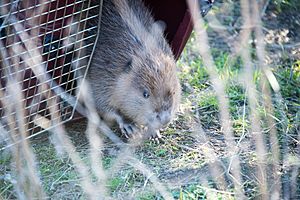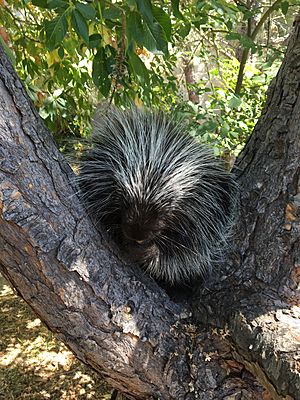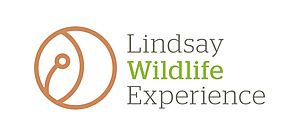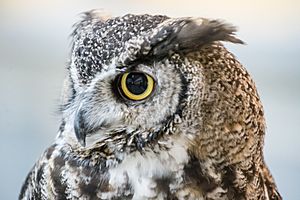Lindsay Wildlife Experience facts for kids
The Lindsay Wildlife Experience is a special place in Walnut Creek, California. It's a family museum and a hospital for wild animals. Lindsay was the very first wildlife hospital in the United States. It's a popular museum in the East Bay Area, close to San Francisco.
The museum started in 1955. Its goal is to help people connect with wildlife. They want to inspire everyone to care for the world we share. The museum has many exhibits about California wildlife. You can see natural history items there too. There's even a special theater where you can watch live animal treatments. The wildlife hospital is one of the biggest in the country. It helps over 5,000 injured, sick, or orphaned wild animals every year.
Contents
The History of Lindsay Wildlife Experience
The Lindsay Wildlife Museum began in 1955. It was first called the Diablo Junior Museum. Alexander Lindsay founded it. After Alexander Lindsay passed away in 1962, the museum was renamed the Alexander Lindsay Junior Museum.
In 1965, the museum moved to a water-pump house. This was in Larkey Park in Walnut Creek. A big step happened in 1970. The museum started the first official wildlife rehabilitation program in the U.S. This means they were the first to have a proper system for helping injured wild animals.
In 1986, the museum became its own independent organization. It was no longer run by the city. The word "Junior" was removed from its name the next year. It became simply the Lindsay Museum. In 1993, the museum moved into a new, larger building. This new building was about 2,600 square meters (28,000 square feet). It was built close to the old pump house.
Three years later, the name changed again to Lindsay Wildlife Museum. In recent years, many new exhibits have been added. The "Wildlife Hospital Behind the Scenes" exhibit lets visitors watch real animal procedures. You can see this through a special one-way window. At the "Raptors" exhibit, you can pretend to fly over Mount Diablo. You can also compare your arm span to a raptor's wingspan.
The "Hive Alive!" and "Hive to Honey" exhibits are about bees. You can watch thousands of live bees and their queen. You learn about the different jobs bees do. In 2013, a new exhibit called "The Burrow" opened. Here, visitors can go "underground." They discover the hidden world of wildlife beneath their feet. The museum changed its name to Lindsay Wildlife Experience in 2015.
The Wildlife Hospital

The wildlife hospital at Lindsay Wildlife Experience is very busy. It takes in over 5,000 wild animals each year. These animals are native to California. The hospital was a pioneer in wildlife rehabilitation. Many of the ways animals are cared for today were first developed here.
Hospital staff and volunteers help animals that are hurt. This includes animals that have been poisoned or hit by cars. They also help animals that fall from trees. Many injuries are caused by human activities. The hospital also cares for young animals that have lost their parents. Some young animals are cared for at the hospital. Others go to the homes of specially trained volunteers.
Once an animal is healthy, it is released back into the wild. If an animal cannot safely return to the wild, it might stay at the museum. These animals become "animal ambassadors." Many animals brought to the hospital are caught by cats. Because of this, the museum strongly asks people to keep their cats indoors.
Animal Ambassadors

Lindsay Wildlife Experience is very good at caring for animals. These are animals that cannot go back to living in the wild. About 70 animals live at Lindsay Wildlife Experience. Almost all of them have a problem. This could be a physical injury or a behavior issue. These problems would make it hard for them to survive on their own.
All the animals living at Lindsay Wildlife Experience are "animal ambassadors." They help teach people about nature and conservation. Some of these animals are on display for everyone to see. Others live behind the scenes. They are brought out for special presentations, classes, and tours. You can even have private meetings with some of them.
Amphibians
Birds
- Acorn woodpecker
- American kestrel
- Bald eagle
- Band-tailed pigeon
- Golden eagle
- Great horned owl
- Harris's hawk
- Mourning dove
- Peregrine falcon
- Red-shouldered hawk
- Red-tailed hawk
- Swainson's hawk
- Turkey vulture
- Western screech owl
- White-tailed kite
Mammals
- Domestic rabbit
- Domestic rat
- Ground squirrel
- Guinea pig
- Mexican free-tailed bat
- North American porcupine
- Virginia opossum
Reptiles
- Aquatic garter snake
- California kingsnake
- California mountain kingsnake
- Common chuckwalla
- Desert iguana
- Pacific gopher snake
- Northern alligator lizard
- Southern alligator lizard
- Western pond turtle
Invertebrates
- Banana slug
- Black widow spider
- Cactus longhorn beetle
- Chilean rose tarantula
- Desert blond tarantula
- Desert hairy scorpion
- Desert millipede
- Madagascar hissing cockroach
- Wolf spider



